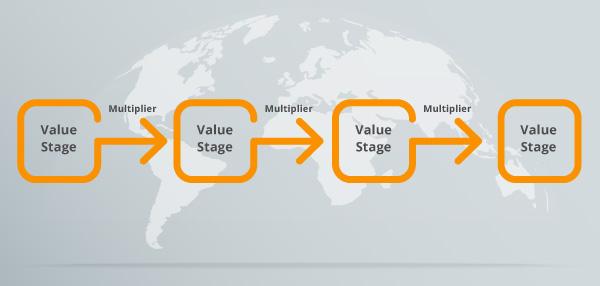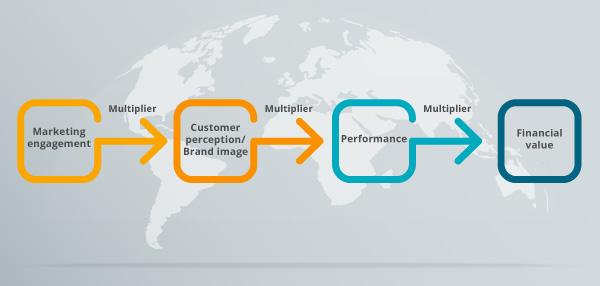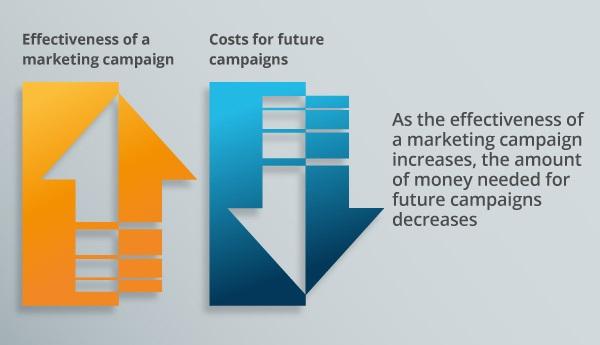Designed to deliver – the powerful impact of following a brand value chain model
| August 17, 2020

“Brand is the sum total of how someone perceives a particular organization. Branding is about shaping that perception.” – Ashley Friedlein
When you make a batch of cookies, the outcome (how well they taste) is influenced by the steps you take, such as the ingredients used, the tools utilized and the directions followed.
Poor ingredients and weak recipes result in treats that don’t taste good. High quality ingredients and an award-winning recipe create delicious cookies.

The structure of how cookies are made is similar to the brand value chain. Like cookies, each part of the brand leads to the important conclusion: what is its overall value (do the cookies taste good)?
In this article, I’ll explain in detail the brand value chain model, so that you can see the different factors that go into a brand’s overall value.
This will help you further your own value, because it becomes clear what types of things need attention in order to succeed. The last thing you want, after all, is a batch of cookies that don’t taste good.
What is a brand value chain?
A brand value chain dictates the process, from start to finish, of how a brand creates value. Using a brand value chain model guides a company through necessary steps needed to improve their value. Though these models seem linear, they often vary.
The beginning reference point for creating a brand value chain model is the Keller and Lehmann study, which moved each value stage along with the help of specific outside factors called ‘multipliers’.
The Keller and Lehmann study shouldn’t be copied word for word, but instead should be a general reference.
I find it most helpful, for anyone creating their own structure, to take the general concepts of Keller and Lehmann’s model and fill in the inputs which best suit you specifically.

The above model will help you visualize how to structure your chain.
Understanding how the model works is easy when you think of it in its most basic, barebones terms: You’re trying to build value. The process begins in the first step (the first value stage), and ultimately leads to the 4th stage (where the value is then measured).
Each step is affected by how well a task is completed, as well as other external factors. This effect is the ‘multiplier’.

As you can see, my stages are: marketing engagement, customer perception/image, market performance, financial value.
Now, I’ll fill in my multipliers so you have the whole picture of the entire process:

The multipliers will act as influences upon the value stage – they suggest how well everything is working, and ultimately how much value will be created at the end of all the stages.
Check out our comprehensive branding guide to further your branding journey.
Value stages
The following are each stage of the brand value chain model, followed by their respective multiplier if applicable.
Value stage 1 – marketing engagement
“Make a customer, not a sale.” – Katherine Barchetti
The initial phase, marketing engagement, details the different ways in which brands reach out to potential customers.
This stage covers the investments into marketing programs that power product research, communications and more.

The overall goal during this value stage is to positively influence the potential client, showing them all the ways in which you can meet their current needs.
This process includes advertisements and marketing campaigns, but these are only half the battle. The other half is affected mostly by your ability to communicate and form relationships with customers.
The first value stage requires a detailed understanding of how your brand, as a whole, communicates with customers.
Multiplier – engagement quality
So, we know that the first stage deals with our marketing engagement and customer relations. The multiplier, in this case, is the quality that goes into each aspect of the process.

Here is a breakdown of each factor to consider – remember that yours may vary slightly, but should be relatively similar:
Suitability
Essentially, this is a measurement of how suitable your marketing program is for the customer’s specific needs.
Make sure to learn, evaluate and understand what types of problems a customer has, then present them your services as the solution.
Uniqueness
This one is crucial, because guess what – you’re not going to have the only marketing campaign a customer will see.

There will be plenty more, in fact. How well will yours stand out? Why should the customer choose you?
Give them a good reason, starting with a unique and enticing marketing campaign that uses brand differentiation to help you stand out from other brands.
Consistency
It almost goes without saying that the performance of your marketing campaigns will be directly affected by how consistent they are.

This includes sticking to values at all times, and using the correct branding elements on different projects and advertisements. A good understanding of brand consistency goes a long way.
Coherence
Above all, your marketing campaigns need to be coherent. Consider the ways in which your target market will construe these campaigns.
Remember that part of this marketing engagement should involve customer feedback. This will give you a general idea how well the campaigns are relating to your audience.
Tying everything together, the first value stage is simply our marketing engagement and how well we are doing it. This will affect the next stage, customer perception and brand image.
Value stage 2 – customer perception and brand image
“The customer’s perception is your reality.” – Kate Zabriskie
The customer perception and brand image stage measures how well customers have responded to the marketing program.
In this part of the process, here are the most important factors:
- Awareness
- Loyalty
- Attitude
I’ll break down all three in detail, after I briefly explain brand image.
Brand image is how a customer perceives a brand. Whatever the brand believes itself to be is irrelevant. The only thing that matters is how the customer see it – the brand image.
Let’s dive into the important factors of this value stage.
Awareness
Awareness is how well customers are able to recognize specific traits and qualities of a brand. It is essentially the popularity of a brand.
Part of brand awareness is how a customer feels when seeing a brand element, such as a logo or color scheme.
Loyalty
Brand loyalty is when a customer uses a particular brand’s services repeatedly, choosing to support them and make purchases from them regardless of price or changes in the market.

Loyalty also implies that a customer will recommend the brand to others, and might remain loyal even if the quality of the service diminishes, though there are limits.
Attitude
Attitude is closely related to feelings that a customer has about a brand. It is usually linked to product performance, though efficacy of marketing campaigns is a factor as well.
Attitude is also driven by a willingness to make necessary changes to services based on customer needs.
Multiplier – current market status
The current market status multiplier influences how well customer perception directly affects the market.

This multiplier depends on the following factors, which I’ll explain in detail:
Competition marketing quality
This is, simply put, the level of quality that your direct competitors produce in their own marketing campaigns.
Similarly, this is usually affected by the response your competitors have in reaction to your marketing projects.
Channel support
Channel support is simply a measurement of how well a brand makes use of all attainable channels.
This response is affected by the branding efforts of the different members of marketing teams and partners.
Customer demographics
The customer demographics refers to different characteristics of the customers who are interested in the brand and its products or services.

These characteristics include things such as the quantity of customers involved, what type of customer they are and how profitable they potentially could be.
The customer perception value stage we just reviewed, leads directly to market performance.
Value stage 3 – market performance
“Growth is never by mere chance; it is the result of forces working together.” – J.C. Penney
The market performance phase measures the total effectiveness the brand has on the market, based on different factors, including:
Market share
Market share is the amount of sales within a market that your brand specifically attains.
This is affected by the amount of customer advocacy or brand advocates you’ve built through marketing campaigns and other factors.
Expansion success
If a brand is successful, it will be a lot easier for them to expand into new markets, which will increase their market value overall.
One way they might do this is by creating a new product or service, that is designed to cater to a new demographic. The reason this is possible is they’ve built their awareness, so the product will be new but the brand behind it won’t.
Cost savings
This result is cyclical, in that the more effective a marketing campaign is, the more you can save on future campaigns.

Price premiums
Sometimes, a brand might place a higher price on an item or service because either the item/service is of higher quality than its competitors, or they want customers to believe it’s of higher quality.
In this case, the higher price is based on the fact that the brand is effective, thus customers will pay a higher price for its products.
Profitability
When everything goes right for a brand’s different marketing campaigns, the brand improves. As this happens, profitability increases.

Multiplier – investor tendencies
Financial experts and investors influence this particular multiplier. Investor tendencies help determine whether or not performance is equally represented in shareholder value.
Current market situation
The investor tendencies, first and foremost, are generally dictated by the current situation of the markets. They’ll respond to it in different ways.
Growth potential
Growth potential is the overall revenue a brand is able to bring in, which fuels speculation concerning how large it can become.
Risk profile
The risk profile details all types of risks and the potential effect those will have on overall well-being.

The market performance value stage, as we see from the factors above, sets up the final stage, financial value.
Value stage 4 – financial value
The final stage is the financial value of the brand. This is where all the factors and influences are calculated and measured, which will then dictate true value. The biggest factors include the stock price and the P/E (price-to-earnings) ratio.
Takeaways
Fill in your own brand value chain and work through each stage. There’s a good chance that something within the steps can be improved.
Remember, not every model will be the same. Personalization becomes maximization.

